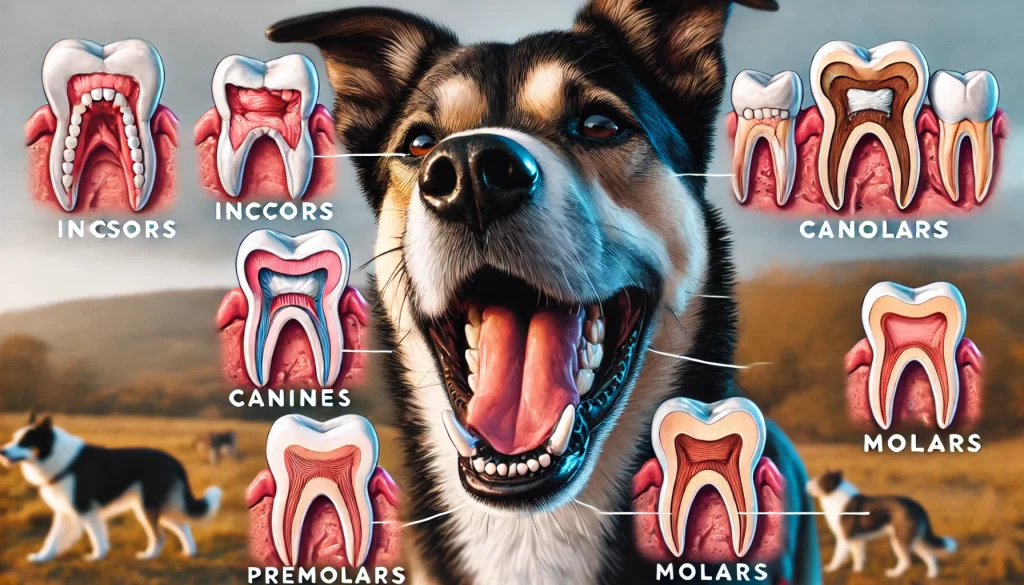How Many Teeth Does a Dog Have? Reveal the Amazing Facts!

Table of Contents
Dogs are our loyal companions, always by our side with a wagging tail and a happy smile. But have you ever wondered how many teeth does a dog have? This question might seem simple, but the answer is full of amazing facts that can help you understand your furry friend better. In this article, we’ll dive into the details of a dog’s dental structure, explore the stages of their teeth, and provide helpful tips on caring for their pearly whites. Let’s explore the fascinating world of canine teeth!
Understanding a Dog’s Teeth: How Many Do They Have?

Dogs have a total of 42 teeth once they reach adulthood. Dogs’ teeth develop at various stages, just like that of people. While puppies start with fewer teeth, their adult counterparts have a complete set designed to help them eat, play, and protect themselves. Knowing how many teeth does a dog have can help you ensure their dental health is on track.
Puppy Teeth: The First Set
Puppies are born toothless, but their first set of teeth, also known as deciduous or baby teeth, start appearing around three weeks. When a puppy is about six to eight weeks old, it typically has 28 baby teeth. These teeth are sharp and tiny, perfect for their early diet of soft foods. Puppies use these teeth to explore their environment and play with their littermates, but eventually, they need a more robust set of teeth to handle more solid food. So, how many teeth does a dog have when they become adults?
Adult Teeth: The Complete Set
When a dog reaches six months, those 28 baby teeth are replaced by 42 adult teeth. These adult teeth are more robust and more suited for a dog’s lifelong needs. The set includes:
- Incisors (12 total): These small teeth are located at the front of the mouth. Dogs use them to nibble on food, groom themselves, and even carry objects gently.
- Canines (4 total): The long, pointed teeth found next to the incisors are used for tearing meat and gripping objects. They are also crucial in a dog’s defense mechanism.
- Premolars (16 total): Positioned behind the canines, these teeth slice food into smaller pieces.
- Molars (10 total): Found at the back of the mouth, molars grind food, especially harder substances like bones or kibble.
These 42 teeth are essential for a dog’s day-to-day activities. So when someone asks, how many teeth does a dog have, you can confidently say they have 42 teeth that serve various essential functions.
The Role of Each Type of Tooth in a Dog’s Life

Each type of tooth in a dog’s mouth serves a unique purpose. From the incisors that help with grooming to the molars that grind down food, every tooth has a job to do. Knowing how many teeth does a dog have and what each one does can help you appreciate the complexity of your dog’s dental health.
Incisors: Small But Mighty
The incisors might be the most minor teeth in your dog’s mouth, but they play a crucial role. Dogs use these teeth for delicate tasks like removing dirt from their fur or gently holding onto objects. When your dog greets you with a toy in its mouth, it’s the incisors doing the job!
Canines: The Protectors
The canines are perhaps the most recognizable teeth in a dog’s mouth. These sharp, long teeth are essential for a dog’s survival in the wild, as they are used to catch and hold prey. In a domesticated setting, they’re more likely to be used for playing tug-of-war or carrying sticks, but their importance remains. Again, understanding how many teeth does a dog have highlights the role of each type of tooth.
Premolars and Molars: The Food Processors
Premolars and molars work together to process food. Premolars cut food into smaller pieces, while molars grind it down, making it easier to digest. These teeth are vital for dogs that eat dry kibble or chew on bones. So, knowing how many teeth does a dog have isn’t just trivia—it’s critical to understanding how they eat and what they need.
Common Dental Problems in Dogs
Like humans, dogs can face dental problems affecting their health and well-being. Understanding how many teeth does a dog have is just the beginning; knowing the common issues that can arise is equally essential. Here are some common dental problems:
Plaque and Tartar Build-Up
Plaque is a sticky film that builds up on a dog’s teeth after eating. If not removed, it hardens into tartar, leading to gum disease and tooth decay. Regular brushing can help prevent plaque and tartar build-up, keeping your dog’s mouth healthy.
Gum Disease: A Silent Threat
Gum or periodontal disease is ordinary in dogs, especially as they age. It occurs when plaque and tartar cause inflammation and infection in the gums. If left untreated, this condition can lead to pain, tooth loss, and even problems with the heart and kidneys.
Broken Teeth: Painful and Preventable
Dogs love to chew, but sometimes bite on something too hard and break a tooth. Broken teeth can be extremely painful and may require veterinary attention. Providing your dog with safe chew toys can help prevent this issue.
Also Read: How Long Does It Take for Semaglutide to Effectively Crush Appetite? 7 Key Insights
How to Care for Your Dog’s Teeth
Caring for your dog’s teeth is essential to prevent dental problems and ensure they live a healthy, happy life. The following advice can help you keep your dog’s teeth in good condition:
Regular Brushing
Brushing your dog’s teeth regularly is one of the best ways to keep their mouth clean. Use a toothbrush designed for dogs and toothpaste that is safe for them to swallow. Make it a point to give them a few weekly teeth-brushing sessions. Knowing how many teeth does a dog have will help you focus on each area of their mouth.
Provide Chew Toys
Chew toys can help reduce plaque build-up by mechanically cleaning the teeth as your dog chews. Choose safe and durable toys, and avoid giving your dog bones or objects that could break their teeth.
Schedule Regular Vet Visits
Regular veterinary check-ups are crucial for monitoring your dog’s dental health. Your vet can perform professional cleanings and check for any signs of dental problems that need to be addressed. Understanding how many teeth does a dog have and keeping them all in good shape should be a priority.
Understanding how many teeth does a dog have is more than just a fun fact; it’s a vital part of caring for your dog’s overall health. Each tooth plays an essential role in your dog’s life, from the sharp canines to the hardworking molars. Caring for their teeth, you’re helping ensure they can eat, play, and smile happily for years to come.
So next time your dog flashes that toothy grin, you’ll know exactly what’s behind it—and how to keep those 42 teeth in tip-top shape!



